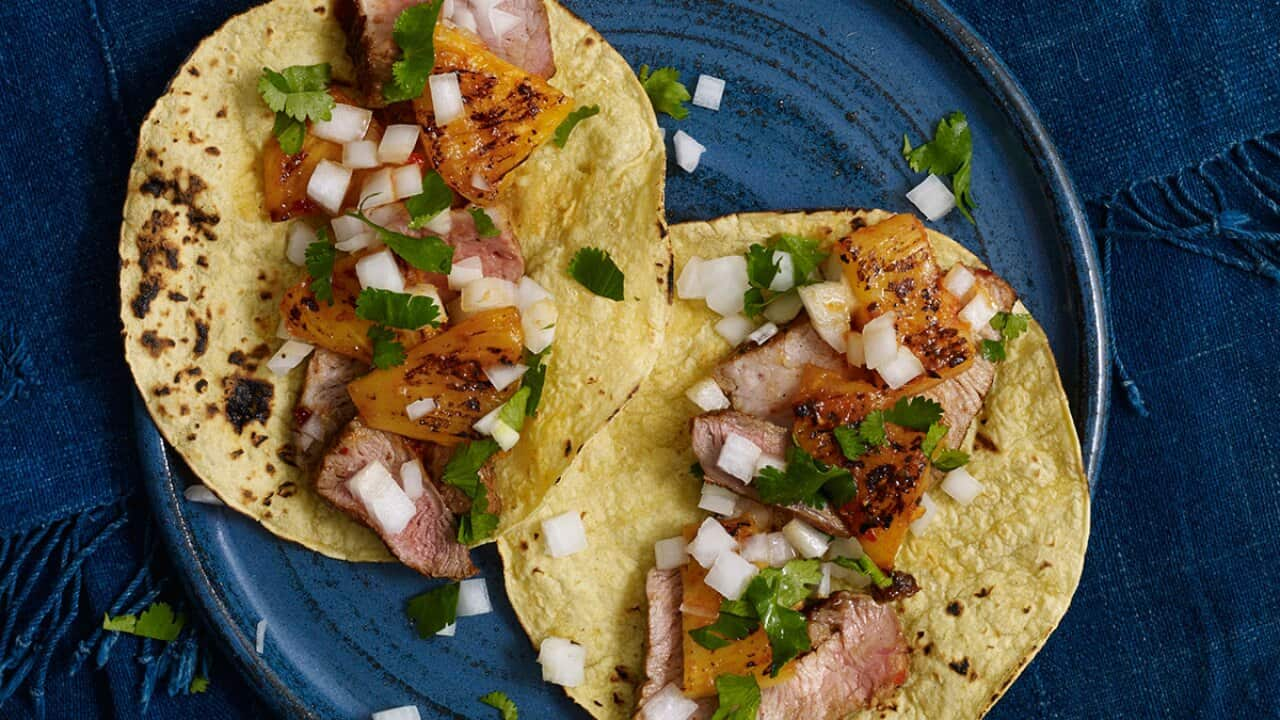--- Watch Season 11 of at 2pm weekdays June 7-20 with episodes available at for 30 days after they air. ---
From visiting a simple riverside hut where two sisters serve up just one dish (and you best not ask for salt!) to eating ‘tacos of the dead’ in Monterrey, Mexico’s second-largest city, the border state of Nuevo León has a lot to offer, as Pati Jinich discovers in the latest season of Pati’s Mexican Table.
Jinich’s travels through the sprawling northeastern region give her a chance to meet families and cooks preserving long-standing traditions, from bread and empanadas cooked in adobe ovens to making piloncillo – a rustic brown sugar – by hand.

Pati Jinich visits a traditional bakery in the town of Bustamante, where three sisters cook in adobe ovens. Source: Pati's Mexican Table

Orange and piloncillo adobo pork roast (Pierna de cerdo en adobo de naranja y piloncillo) Source: Pati Jinich
Ahead of the new season starting in Australia, we talked to Jinich about all the deliciousness she discovered.
Can you tell us more about the wonderfully named 'poison beans' – frijoles con veneno – that you cook in the third episode? Are these a traditional Monterrey dish?
YES!! Poison is a slang used in Mexico when you LOVE something in food, such as a hot sauce, or a seasoning... and it may be spicy or heavy but you can’t do without. Here they are called poison beans, because the base of their seasoning is the adobo sauce from the adobo pork, which is a beloved dish in the region. And everyone has their own tweak to it, so everyone will add their own "poison" that gives the personality to the beans.
In episode 5, you take part in a once-a-year piloncillo-making celebration with the Garza family. Had you ever had a chance to make piloncillo before?
The celebration takes place in a town called Bustamante – it was my very first time making piloncillo from scratch! From cutting down the sugar cane, pressing the fresh juice (and tasting it!) and then cooking it slowly and steadily until it hardens to the point that it can be poured and solidified. It is like Mexico's molasses of sorts. The purest form of sugar is made from sugar cane. It has a tangy and really unprocessed kind of farm-yard taste – super charming and delicious.

Making pilonchillo. Source: Pati's Mexican Table
YES of course!!! YES!! Baking and bread is big in northern Mexico and they are very proud of it. And bread tastes very special there, because most times, they use Sonoran wheat and piloncillo to sweeten the bread -they have a very homey taste and feel. It was amazing meeting so many bakers, from the sisters in Bustamante that make super traditional empanadas and bread to Chuy who is trying to take breads on a more modern and trendy direction and of course, Irving who is like a bread Encyclopedia and is all about good technique and good results.

A delicious meet-up with Irving Quiroz. Source: Pati's Mexican Table

Pati's pineapple empanadas. Source: Pati Jinich
Those are ! They get that nickname because the taco stand is right next to the cemetery. And people just line up on the weekends for those. The stand has a lovely story, the woman has worked on it for ages and now is at the helm since her husband passed away...
And NO. I never travel to Mexico without trying a taco, because not only are there unique and delicious tacos to every town, city, and even family, but also, in Mexican food, we tend to tuck other things INTO tortillas practically turning them into tacos. So there is no escaping them.
What else have you been working on - any new projects, or new recipes you've been having fun with at home? Like those good-looking we spotted on your Instagram?
Well, now I am testing recipes for the next season of Pati's Mexican Table which will be featuring the state of Yucatan!! And yes, having a lot of fun with masa like those tacos rojos and different kinds of tamales. I am also now obsessing over the stories of my new series which is all about the US/Mexico borderland communities.








